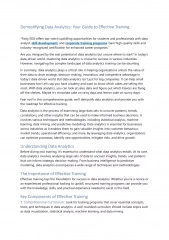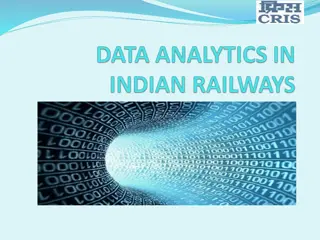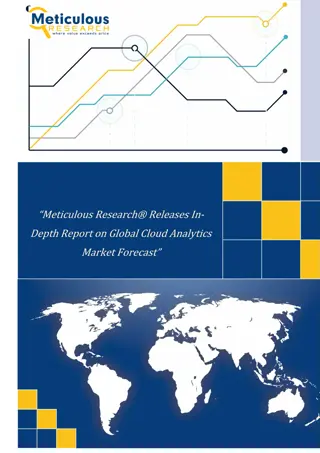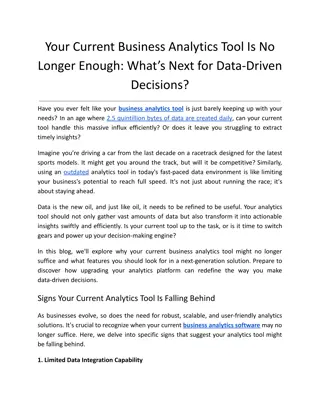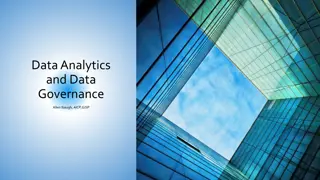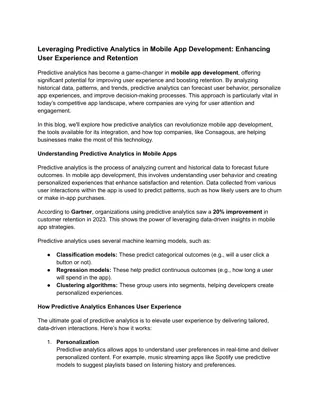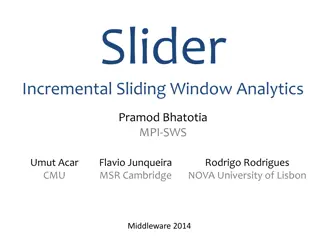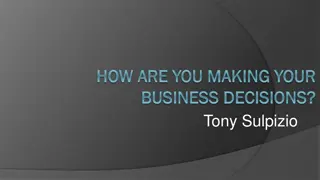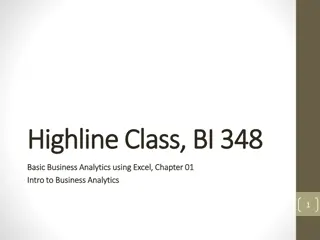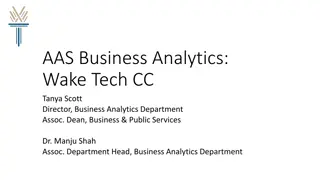Transforming Analytics Landscape with Data Governance: A Strategic Approach
Data governance is a strategic priority crucial for managing data effectively in today's landscape. It involves defining policies, procedures, roles, and responsibilities to ensure ethical use, compliance with regulations, and maximization of data investments. Key elements include strategic empowerment, rules, and constraints, with a focus on promoting efficiency, trust, risk reduction, and deeper insights while aligning with business goals and ensuring data quality and security.
Download Presentation

Please find below an Image/Link to download the presentation.
The content on the website is provided AS IS for your information and personal use only. It may not be sold, licensed, or shared on other websites without obtaining consent from the author. Download presentation by click this link. If you encounter any issues during the download, it is possible that the publisher has removed the file from their server.
E N D
Presentation Transcript
How to transform the landscape of analytics with data governance Richard R. Burnette III, PhD Associate Provost for Metrics, Analytics and Strategic Planning, and Institutional Data Administrator Florida State University Braden J. Hosch, PhD Associate Vice President for Institutional Research, Planning & Effectiveness Stony Brook University
Data governance is a strategic priority Proliferation of data and applications Privacy expectations/ regulations Cloud data mobility Fair and ethical use
The 5-second elevator definition a set of guidelines for how people behave and make decisions about data Data governance is
What is Data Governance? John Ladley Data governance is the organization and implementation of policies, procedures, structure, roles, and responsibilities which outline and enforce rules of engagement, decision rights, and accountabilities for the effective management of information assets. Implement Identify Policies Rules Procedures Rights Structures Accountabilities Roles Expectations Responsibilities Opportunities
Important characteristics of DG definitions Data governance IS More about people and behavior than data Data Governance IS NOT IT s responsibility Solved by technology A system that requires and promotes shared agreement Equally applied across all data assets Formal (i.e. written down) Adds value by supporting institutional mission/goals
Complementary Elements of Data Governance Strategic Empowerment Rules & Constraints
Why Do We Need Data Governance? Maximize Data Investments Gain Deeper Insights Promote Efficiency Improve the Experience Ensure Trust Reduce Risk
Principles of Data Governance Responsibility and accountability defined across the data lifecycle and recorded in the information asset register Consistency of data in its sourcing and in its vocabulary, definitions, and taxonomies Quality which is proactively assessed and standards applied Business alignment which ensures that data is regarded and treated as a key business asset Secure access to relevant users, kept secure through access control Insight Source: Carruthers, C. & Jackson, P. (2018). The chief data officer s playbook, London: Facet, p. 145
What are the Data Dimensions Use Access Management Integrity Privacy Security Visible Elements
What Data are we Governing? ERP Data and Operational Data Administrative SIS, HR, Financials, CRM, Departmental, Organizational Performance Data Teaching & Learning Instructor and Student Performance LMS, Lecture Capture, Clickers, Attendance, Engagement, Grades, Progression, and Course and Faculty Evaluations Data on Researchers, Research & Grants Research Publication and Citation Histories, Proposals Submitted, Research Content & Results, Grant Dollars, PI and Co-PI data, Graduate and Undergraduate Research Both Internal and External Data Other Types Meta-data, Unstructured Data, Geo-location, Event Attendance, Organization Involvement, Social Media, Sentiment Analyses, Survey Data, Business Transactions, Vendor Data
Key features of data governance systems Documents Groups Individual roles Charter / framework Principles & values Purpose & scope Roles & responsibilities Senior leadership [buy-in] Data stewards Policy council Data custodians/ caretakers Data steward council(s) Data users Written & published policies Data dictionaries Communication strategies Information security council/program Positions/office to support DG
Common Elements of the Structure Committees Executive/Steering Senior officials focused on holistic goals of institution Data Strategy Occasionally separate from above focused on better data use Operational Governance Responsible for executing policies and procedures Data Standards Maintains data elements and monitors quality and delivery Chief Data Officer (CDO) Often overseas the execution of institutional goals Roles Data Trustees Subject matter owners responsible for data integrity and clarity Data Stewards Responsible for assigning access and assuring standards met Data Custodians Usually IT maintaining security, backups, recovery, availability Data Consumers Functional staff who interact with data and report on data
Structure Generic Example Executive Steering Committee Authorized to change the organization Drives cultural change Supports the program enterprise-wide Provides funding for the Data Governance Program Data Governance Board Made up of high-ranking representatives of data- owning business functions who can make decisions about data for the company Assign members of the Data Stewardship Council Approve decisions of the Data Stewardship Council Approve data-related policies Business Data Stewards Experts on use of their data domain data Able to reach out to SMEs to gather information and make decisions Typically someone who others come to as the most knowledgeable about the meaning of the data (and how it is calculated) Makes recommendations on data decisions and write data-related procedures Plotkin (2014). Data stewardship: An actionable guide to effective data management
COMPLIANCE EXECUTIVE STEERING COMMITTEE Oversight Vision Funding Leadership Chief Data Officer Human Resources Fair & Ethical Use INFORMATION GOVERNANCE COUNCIL Policies Permissions Procedures Arbitration Strategy Evaluation Oversight Data Sciences Financials Functional Governance Groups Student Information Data Strategy Alumni & Foundation Business Intelligence DATA CUSTODIANS
Information Governance Council Purpose Create a data governance imperative Create access control mechanisms Promote a data- engaged campus Create and update policies Authorize data movement and storage Manage conflict resolution Promote shared data management Reinforce reporting controls Define and arbitrate fair and ethical use Evaluate and assess effectiveness
Data Steward Responsibilities Oversee management of selected data assets Participate in data governance and carry out decisions Assist in creation and maintenance of data dictionaries, metadata Document rules, standards, procedures, and changes Ensure data quality and manage specific issues Communicate appropriate use and changes Manage access and security
Functional Data Stewardship Council/Committees Set / review definitions, data quality rules, creation/usage rules, metadata Consider and approve changes to code sets Coordinate data stewards in related area Enforce data dictionary standards in area Respond to inquiries about process, content, limitations and uses of data, especially in cross- functional settings Review data quality in functional area; identify practices promoting data quality Communicate proceedings, including notice of changes and decisions Elevate issues that require resolution
Data users Expectations should be set for data users. Example formal responsibilities (Stony Brook) Recognize that institutional data are potentially complex. Make efforts to understand the source, meaning and proper use of the data Report data quality issues to appropriate data steward Include information about the data source and criteria to guard against misinterpretation s of data. Ensure that passwords or other security mechanisms are used for sensitive data Respect the privacy of individuals whose records they may access.
Keys to Implementation Identify structure and roles on governance committees Plan Create value statement for DG Identify rough costs and staffing meetings and document via shared media Prepare a roadmap Design the program
Additional Keys to Implementation Create mechanisms for documenting compliance Prepare policy documents Adopt Maturity Model Brand process with visible brand Prepare training protocols Measure and report on activities Identify early wins
Technology applications for data governance Technology can support data governance Data dictionary management Data quality analysis Master data management Issue and process management Technology will not Build organizational structures, responsibilities, accountabilities Mend dysfunctional organizations Implement organizational or cultural change
Example Data Governance Maturity Model Level 1 Level 2 Level 3 Adopted and Implemented Data Governance structures, roles and processes are implemented and fully operational. Level 4 Managed and Repeatable Data Governance structures, roles and processes are managed and empowered to resolve data issues. Level 5 Integrated and Optimized Informal Developing Data Governance Program is forming with a framework for purpose, principles, structures and roles. Attention to Data Governance is informal and incomplete. There is no formal governance process. Data Governance Program functions with proven effectiveness. Organizational Structures There is active participation and acceptance of the principles, structures and roles required to implement a formal Data Governance Program. Data issues are captured proactively through standard data validation methods. Data assets are identified and valuated. Data is viewed as a critical, shared asset. There is widespread support, participation and endorsement of the Data Governance Program. Data governance structures and participants are integral to the organization and critical across all functions. General awareness of the data issues and needs for business decisions. Limited awareness about the value of dependable data. Culture General awareness of data quality importance. Data quality procedures are being developed. Data quality efforts are regular, coordinated and audited. Data are validated prior to entry into the source system wherever possible. Limited awareness that data quality problems affect decision- making. Data clean-up is ad hoc. Expectations for data quality are actively monitored and remediation is automated. Data Quality Written policies, procedures, data standards and data dictionaries may exist but communication and knowledge of it is limited. Data standards and policies are communicated through written policies, procedures and data dictionaries. All employees are trained and knowledgeable about data policies and standards and where to find this information. Information regarding data is limited through informal documentation or verbal means. Data standards and policies are completely documented, widely communicated and enforced. Communication Roles and responsibilities for data management are forming. Focus is on areas where data issues are apparent. Roles and responsibilities are well-defined and a chain of command exists for questions regarding data and processes. Roles, responsibilities for data governance are well established and the lines of accountability are clearly understood. Roles and responsibilities for data management are informal and loosely defined. Expectations of data ownership and valuation of data are clearly defined. Roles & Responsibilities
Person Roles CDO Chief Data Officer CISO Chief Information Security Officer Chief Privacy Officer Chief Compliance Officer Institutional Data Administrator Data Stewards Data Custodians Data Manager
Key Policies Strategic Vision/Policy for Data Use Information Privacy Data Access and Use Data Management (includes 3rd Party) Cybersecurity Email and Media Use Survey Administration Data & Device Security Fair and Ethical Use
Takeaways Data governance is more about people than data All higher ed change management principals apply Process and written documents are essential Leadership support Broad-based consultation, including faculty Opportunity for consultation Representation Software can help, but it won t fix broken processes or organizations Starting data governance is hard work; sustaining it is harder
Questions? Rick Burnette Associate Provost for Metrics, Analytics and Strategic Planning, and Institutional Data Administrator Florida State University rburnette@fsu.edu Braden Hosch Associate Vice President for Institutional Research, Planning & Effectiveness Stony Brook University Braden.hosch@stonybrook.edu










